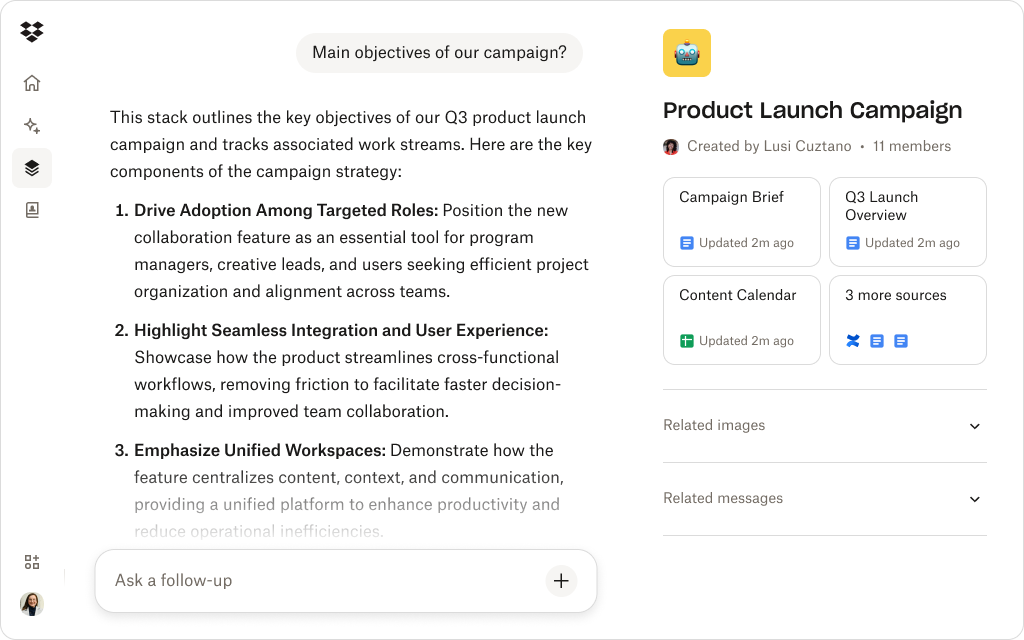
AI can speed up tasks—but without structure, shared context, and trust, collaboration breaks down.
It’s never been easier to work faster, but never harder to stay aligned. Most people have used AI to do the following:
- Draft emails
- Summarize meetings
- Generate ideas
AI does this and more in seconds. But when teams don’t have a shared system for organizing that output—or a common understanding of what’s current, approved, or accurate—all that speed turns into chaos.
Every disconnected document, unverified answer, or misaligned file version chips away at the collaborative spirit that teams thrived upon before AI. That means what starts as efficiency can become confusion, causing:
- Duplicate work
- Mixed messages
- Decision fatigue
- Poor team morale
Successful teams focus on automation and alignment in tandem. They build a foundation of shared context, actionable knowledge, and trusted information—so everyone moves faster together.
Tools like Dropbox Dash make the process of building that foundation easier—working as a connector, keeping teams on the same page even as the pace of work accelerates.
The paradox of AI-powered collaboration
It’s the paradox of AI collaboration. Tools promise to make teamwork easier, but they often create new silos instead. Each department adopts different platforms, each with its own rules, data sets, and outputs.
Here are a few consequences of that approach, which slows modern teams down:
- Marketing builds prompts and content in one AI platform that creative can’t access
- Product teams store insights in systems no one else can search or summarize
- Operations rely on reports that are current in one tool but outdated everywhere else
- Leadership gets fragmented updates instead of a clear, connected picture
- Everyone spends more time syncing than solving
These outcomes demonstrate that, without a common system, collaboration becomes fragmented. When that happens, teams end up redoing work, repeating insights—or making decisions in isolation.

Why tools alone don’t build teamwork
True collaboration relies on context and alignment. Access to tools is important, but how tools are used is often an afterthought.
AI can help to generate ideas or automate repetitive tasks, but it can’t guarantee that everyone’s working from the same source of truth.
Here’s what happens when tools outpace teamwork:
- Different truths—teams reference conflicting versions of the same document
- Disconnected efforts—AI generates parallel ideas that never get merged or shared
- Invisible progress—work moves forward in one channel while others are left behind
- Lost accountability—without clarity on ownership, deadlines slip through the cracks
- Shallow collaboration—automation speeds up tasks but skips the nuance of shared understanding
Without human coordination, AI-driven workflows risk amplifying miscommunication. The technology helps, but only if it’s grounded in shared structure, goals, and visibility.
The hidden risks of fragmented AI use
AI adoption is accelerating. However, without structure, it can create as many problems as it solves.
When every team picks its own platform, processes drift, data splinters, and trust in results erodes. The promise of efficiency quickly turns into a patchwork of disconnected systems that just slow everyone down.
When teams use multiple disconnected AI tools, three key issues emerge that stall collaboration:
- Duplication: Similar tasks are repeated across tools with no awareness of each other’s outputs. That means teams waste hours reinventing work that already exists—losing both time and creative energy. If someone makes an extra coffee, no big deal—but if they do project work twice, that can be days of productivity lost.
- Version confusion: Different AI systems produce overlapping or contradictory results. Without a shared record of truth, teams don’t know which answer to trust—and decisions stall under uncertainty. Clear versioning and always being able to find the latest files are crucial to spurring effective collaboration.
- Data security risks: Information copied between tools can fall outside of admin permissions or compliance policies. A team might even adopt a tool beyond the scope of IT leaders, creating shadow AI use, which means sensitive content can easily slip through the cracks, putting teams at risk of leaks, fines, or reputational damage.
The risks are real and growing with adoption rates. According to IBM’s Enterprise Guide to AI Governance, 63% of business leaders are concerned about regulatory or compliance risks tied to AI adoption.
These risks show that alignment matters just as much as innovation. Tools like Dash help eliminate these blind spots—connecting data, context, and permissions under one system, allowing teams to work together effectively.
What real AI collaboration should look like
The future of work involves amplifying what teams can do together. The best AI connects team effort. It helps teams move faster without losing alignment, transforming scattered contributions into shared progress.
AI should connect people instead of replacing collaboration. In effective teams, AI augments workflows by:
- Summarizing and sharing insights across projects
- Integrating with the tools teams already use
- Respecting permissions and ownership
- Creating visibility instead of silos
Real collaboration is about shared understanding and collective decisions, not parallel automation. Dash was built to embody that, connecting tools and knowledge into one intelligent workspace where AI strengthens teamwork.

How Dash helps teams collaborate with AI
AI can be a powerful teammate when everyone’s working from the same playbook.
Without shared context, automation can splinter communication and create more confusion than clarity. Dash solves that by connecting all your favorite apps—bringing people, files, and conversations together in one space.
Here are a few ways AI becomes the glue that holds teamwork together in Dash:
- Shared workspace: Dash gives teams a single, AI-enhanced environment where everyone sees the same information. No more version conflicts or disconnected updates—just one shared view of progress.
- Context built in: Dash Chat summarizes updates and surfaces next steps, so knowledge is never siloed. Teams can act quickly because everyone knows what’s happened, what’s next, and why it matters.
- Permission-aware AI: Dash has superb security that respects Dropbox access controls, which keeps data safe and collaboration structured. Every insight stays protected, ensuring that AI works within your guardrails.
- Connected content: Dash links documents, meetings, and messages, ensuring AI insights stay tied to the right projects. You can even use the handy start page so teams can see everything at a glance during each workday.
As Dash connects people, files, and context in one place—it helps AI serve the team, not the other way around. It helps spur collaboration by keeping work transparent, connected, and confidently human.
See how Dash powers AI collaboration
Dash unites your files, people, and projects in one searchable, secure workspace for true collaboration.
Best practices for AI-driven collaboration
When teams adopt new tools without structure, collaboration can devolve into confusion. Building shared habits around how AI is used keeps creativity flowing while maintaining trust, security, and alignment.
Here’s how to keep AI-driven collaboration consistent and effective:
- Choose shared tools—standardize platforms so teams work in the same environment
- Maintain version control—store AI outputs in shared folders with clear naming conventions
- Train for context—teach teams how to prompt and verify AI results
- Document everything—record decisions and outcomes from AI-driven projects
- Review governance—revisit permissions and data policies regularly
When these practices become routine, AI becomes a reliable teammate. Dash makes it simple to bring that structure to life—connecting the tools, files, and people that make automation turn into real collaborative spirit.
Build stronger teamwork with Dropbox Dash
AI can enhance teamwork—but only if the collaboration is connected, transparent, and secure. Dash gives teams that foundation.
With shared access, structured context, and permission-aware AI, Dash ensures everyone’s working from the same truth. See how Dash helps teams collaborate smarter and faster—contact sales or try a demo today.
Frequently asked questions
AI tools speed up work but often create silos when teams use different systems without shared structure or context. Speed means nothing without alignment—true collaboration needs a single source of truth, not a collection of disconnected shortcuts.
Dash unites tools, files, and permissions so teams can collaborate within one consistent, searchable workspace. It turns AI from a set of isolated apps into a shared ecosystem—where everyone works faster, together, and in sync.
Yes. Dash keeps permissions intact through Dropbox, ensuring sensitive data stays within authorized access. It’s AI with guardrails—giving teams the freedom to create without ever compromising trust or security.
Get started with Dash
.webp)

.svg)


